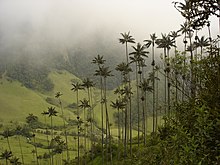Ceroxylon quindiuense
| Ceroxylon quindiuense | |
|---|---|

| |
| Ceroxylon quindiuense growing wild in Cocora Valley near Salento, Colombia | |
| Scientific classification | |
| Kingdom: | |
| (unranked): | |
| (unranked): | |
| (unranked): | |
| Order: | |
| Family: | |
| Genus: | |
| Species: | C. quindiuense
|
| Binomial name | |
| Ceroxylon quindiuense | |
| Synonyms[2] | |
| |
Ceroxylon quindiuense, is a palm native to the humid montane forests of the Andes in Colombia and northern Peru.[3]
Description

This palm species can grow to a height of 45 m (148 ft)—or rarely, even as high as 60 m (200 ft).[3] It is the tallest recorded monocot in the world.[4] The trunk is cylindrical, smooth, light colored, covered with wax; leaf scars forming dark rings around the trunk.[3] The leaves are dark green and grayish, 185–540 cm long, with a petiole up to 80 cm long.[3] Fruits are globose and orange-red when ripe, 1.6–2 cm in diameter.[3]
Ecology
It grows in large and dense populations along the central and eastern Andes of Colombia (rarely in the western Colombian Andes), with a disjunct distribution in the Andes of northern Peru.[3] The elevational range of this species is between 2,000 and 3,100 m (6,600 and 10,200 ft) above sea level.[3] It achieves a minimum reproductive age at 80 years.[5] Wax palms provide habitats for many unique life forms, including endangered species such as the yellow-eared parrot (Ognorhynchus icterotis).
Vernacular names
Palma de cera, palma de ramo (both names in Colombia).[3]
Conservation
Populations of Ceroxylon quindiuense are threatened by habitat disturbance, overharvesting and diseases.[5] The fruit was used as feed for cattle and pigs. The leaves were extensively used in the Catholic celebrations of Palm Sunday;[6] such leaves coming from young individuals which were damaged to death.[5] That activity has been reduced severely in recent years due to law enforcement and widespread campaign.[3] Felling of Ceroxylon quindiuense palms to obtain wax from the trunk also is an activity still going on in Colombia and Peru.[3] The palm is recognized as the national tree of Colombia, and since the implementation of Law 61 of 1985, it is legally a protected species in that country.[5][7]
Cultivation and uses
The wax of the trunk was used to make candles, especially in the 19th century.[3] The outer part of the stem of the palm has been used locally for building houses, and was used to build water supply systems for poor farmers.[3][5] It is cultivated as an ornamental plant in Colombia and USA.[3][5]
References
- ^ http://www.iucnredlist.org/details/38467/0
- ^ "The Plant List: A Working List of All Plant Species".
- ^ a b c d e f g h i j k l m Sanin, Maria Jose; Galeano, Gloria (2011). "A revision of the Andean wax palms, Ceroxylon (Arecaceae)" (PDF). Phytotaxa (34): 47–50. Retrieved 26 January 2016.
- ^ "Ceroxylon quindiuense - Palmpedia - Palm Grower's Guide". www.palmpedia.net. Retrieved 26 January 2016.
- ^ a b c d e f Madriñan, S.; Schultes, R.E. (1995). "Colombia's national tree: the wax palm Ceroxylon quindiuense and its relatives" (PDF). Elaeis. 7 (1): 35–56.
- ^ "Bogotá, 'Reconcíliate con la Naturaleza' este Domingo de Ramos". En Detalle. Portal Bogota WACG. Retrieved 26 January 2016.
- ^ Presidencia de la República de Colombia. "Símbolos patrios" (in Spanish).

